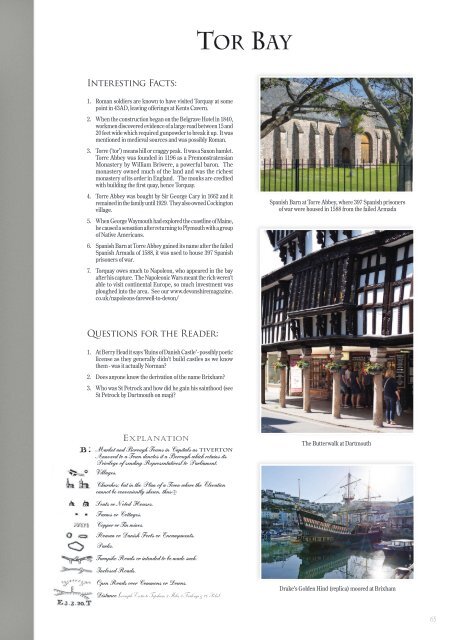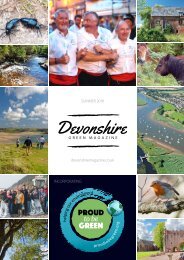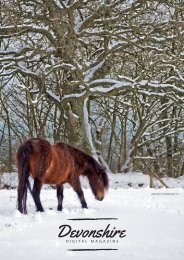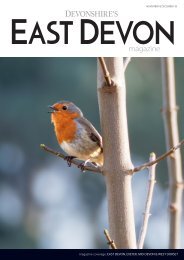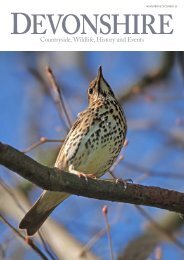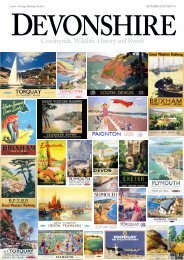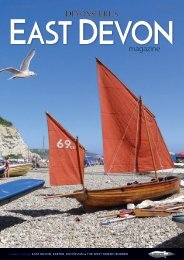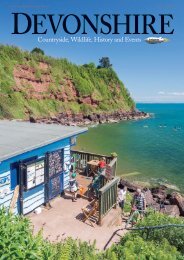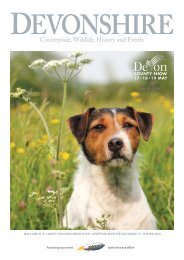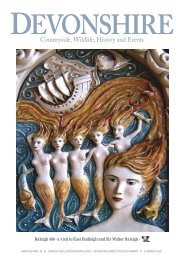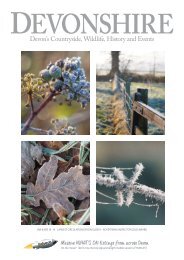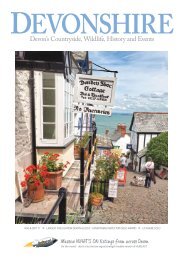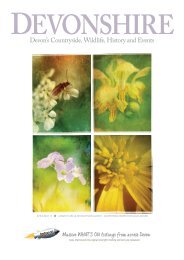Devonshire June July 16
Everything Devon: Countryside, Wildlife, History, Events, Music
Everything Devon: Countryside, Wildlife, History, Events, Music
Create successful ePaper yourself
Turn your PDF publications into a flip-book with our unique Google optimized e-Paper software.
Tor Bay<br />
Interesting Facts:<br />
1. Roman soldiers are known to have visited Torquay at some<br />
point in 43AD, leaving offerings at Kents Cavern.<br />
2. When the construction began on the Belgrave Hotel in 1840,<br />
workmen discovered evidence of a large road between 15 and<br />
20 feet wide which required gunpowder to break it up. It was<br />
mentioned in medieval sources and was possibly Roman.<br />
3. Torre ('tor') means hill or craggy peak. It was a Saxon hamlet.<br />
Torre Abbey was founded in 1196 as a Premonstratensian<br />
Monastery by William Briwere, a powerful baron. The<br />
monastery owned much of the land and was the richest<br />
monastery of its order in England. The monks are credited<br />
with building the first quay, hence Torquay.<br />
4. Torre Abbey was bought by Sir George Cary in <strong>16</strong>62 and it<br />
remained in the family until 1929. They also owned Cockington<br />
village.<br />
5. When George Waymouth had explored the coastline of Maine,<br />
he caused a sensation after returning to Plymouth with a group<br />
of Native Americans.<br />
6. Spanish Barn at Torre Abbey gained its name after the failed<br />
Spanish Armada of 1588, it was used to house 397 Spanish<br />
prisoners of war.<br />
7. Torquay owes much to Napoleon, who appeared in the bay<br />
after his capture. The Napoleonic Wars meant the rich weren't<br />
able to visit continental Europe, so much investment was<br />
ploughed into the area. See our www.devonshiremagazine.<br />
co.uk/napoleons-farewell-to-devon/<br />
Spanish Barn at Torre Abbey, where 397 Spanish prisoners<br />
of war were housed in 1588 from the failed Armada<br />
Questions for the Reader:<br />
1. At Berry Head it says 'Ruins of Danish Castle' - possibly poetic<br />
license as they generally didn't build castles as we know<br />
them - was it actually Norman?<br />
2. Does anyone know the derivation of the name Brixham?<br />
3. Who was St Petrock and how did he gain his sainthood (see<br />
St Petrock by Dartmouth on map)?<br />
Market and Borough Towns in Capitals as Tiverton<br />
Annexed to a Town denotes it a Borough which retains its<br />
Privilege of sending Representativesl to Parliament.<br />
Villages.<br />
Churches; but in the Plan of a Town where the Elevation<br />
cannot be conveniently shewn, thus<br />
Seats or Noted Houses.<br />
Farms or Cottages.<br />
Copper or Tin mines.<br />
Roman or Danish Forts or Encampments.<br />
Parks.<br />
Turnpike Roads or intended to be made such.<br />
Inclosed Roads.<br />
EXPLANATION<br />
Open Roads over Commons or Downs.<br />
Distance (example Exeter to Topsham, 3 Miles, 3 Furlongs & 20 Poles)<br />
The Butterwalk at Dartmouth<br />
Drake's Golden Hind (replica) moored at Brixham<br />
65


